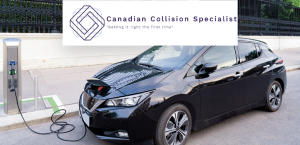Comparing EVs and traditional vehicles for future repair
Column by JOHN MARLOWE
Once again, it seems that the more things change, the more they remain the same.
What really changes when we repair a collision damaged EV or Hybrid instead of a traditionally powered vehicle? Sure, there’s a few extra steps in ensuring the vehicle is safe to work on, and perhaps a larger repair bay is needed. Once we’ve followed the correct procedures to render the vehicle safe to work on, what’s different, really?
Most of the EVs that we see in collision repair facilities today (indeed, that we’ve seen for the past 20ish years!!) feature structures that are no different from those vehicles equipped with gasoline or diesel engines. Take away the drive gear and energy storage systems, and these are the very same vehicles that we’ve been repairing forever.
Much like learning to safely handle a gasoline tank during collision repair (which can instantly unleash full energy potential in the form of an explosion under certain conditions), safely handling EV batteries requires investment in training, tooling, environmental configuration, and process integration. Every collision repair requires intensive research to identify procedures, parts and other critical elements needed to ensure that vehicles are leaving our facilities with all the damage identified and corrected in the proper way.
If we break things down into individual systems, it’s easy to see that successfully and safely repairing EV and Hybrid vehicles is more of an opportunity to leverage existing skills and equipment to our advantage and to adapt our foundational expertise to allow us to handle the comparatively few elements that are very different.
• Diagnostic scanning is a critical part of the repair process no matter what type of vehicle is being repaired. No new learning curve here.
• Exterior bolt-on parts such as hoods, liftgates, doors, fenders and bumpers are handled in the usual ways. The OE repair manual will help identify when to repair or replace, which parts are one-time use, and any other considerations such as ADAS systems and other sensing devices.
• Welded, riveted, or bonded panels such as roofs, rear body panels and ¼ panels are also handled using the same techniques and equipment regardless of the type of drive system.
• Replacing a front rail on a uni-body vehicle? You’re likely removing the drive gear, whether it’s a gas engine with a transaxle or an electric motor with a single reduction gear. The instructions are in the OE repair manual, and you’re using familiar equipment and skills to perform the operations.
• Does the collision damage involve wheels, suspension, brakes, or steering systems? You already have the skills and equipment to handle these, and the vehicle specific information is in the OE repair manual.
• Vehicle lighting, instrumentation, electrical convenience and other “low voltage” equipment also remains essentially universal in how we approach repairing and replacing components.
• Bonded glass? Electric or ICE, use the same skills and tools (and consult your OE repair manual).
Very nearly every element of repairing collision damaged vehicles is unchanged regardless of what moves the vehicle down the road. The differences? Well, they’re few, but they’re important.
Failing to understand these differences and how to handle them can put people at risk of injury or death and could cause permanent (and VERY expensive) damage to electrical systems, especially the batteries.
Here is a generalized list of requirements which is by no means exhaustive:
• A designated outdoor quarantine area.
• An oversized repair bay.
• Hand tools and PPE specifically designed for working on high voltage systems.
• High voltage electrical diagnostic equipment
• A set of wheel dollies.
• Training for your A/C technician (A/C systems on EVs and Hybrids require special considerations, including the use of non-conductive oil).
• A 2-post lift with suitable capacity for lifting EVs.
• A method of lifting/handling EV batteries (methods differ by vehicle manufacturer).
• A method of charging EV batteries.
A piece of equipment that is not specific to EV repair, but is required, is a vacuum fill system for coolant. Many vehicles now require that the cooling system be filled using a vacuum system to ensure that no air is present in the system. On many ICE vehicles, it is no longer possible to reliably
Comparing EVs and traditional vehicles for future repair“burp” the cooling system by filling it with the engine running and waiting for the air to chug out as the system heats up. For many years, a lot of vehicles had built-in bleeder systems to ensure the air was removed.
EV and Hybrid liquid cooling systems (most EVs have liquid cooling for the batteries) absolutely must be filled using a vacuum system. I felt that this deserved a special mention due to the number of EVs that we see where the collision shop has researched the procedures for de-energizing the high voltage system so their techs can safely work on the vehicles, but then failed to research the coolant-fill procedure leaving the high voltage system vulnerable to damage or failure from lack of cooling.
Now, I hear you out there. You’re asking, “What about the new skateboard chassis that EV manufacturers are developing? We don’t see ICE vehicles with those!”
There are only two things to say about repairing skateboard chassis vehicles.
1. Tesla has been using them for years. You need to make sure you have access to OE repair procedures so you can ensure you have the necessary training and equipment
2. They aren’t new. The single highest volume production automobile in history, the Volkswagen Type 1 (Beetle), with 21.5 million examples built between 1938 and 2003, was constructed using a skateboard chassis. If our great-grandparents could handle these, we can too. The more things change.














































































